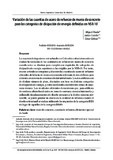Response of thin lightly-reinforced concrete walls under cyclic loading

Compartir este ítem
Fecha
2018Autor
Blandon C.A.
Arteta C.A.
Bonett R.L.
Carrillo J.
Beyer K.
Almeida J.P.
Citación
Metadatos
Mostrar el registro completo del ítemResumen
During the last two decades, thin concrete walls have been frequently used to brace mid- to high-rise buildings in some Latin American countries. This structural system differs significantly in terms of wall geometry and reinforcement layout from traditional cast-in-place reinforced concrete wall buildings. Limited experimental data on this wall system and the absence of post-earthquake field observations make it difficult to assess whether such walls behave similarly to the walls designed according to the current local design code. The paper presents and discusses the results of an experimental program comprising quasi-static cyclic tests of four slender, thin and lightly-reinforced concrete walls with different geometrical configurations, steel properties and reinforcement layouts, which correspond to a common construction practice in Colombia. The seismic response of the specimens was assessed in terms of crack propagation and failure modes, hysteretic and backbone curves, contribution of rocking, flexural, shear and sliding components to lateral drift, stiffness degradation, and energy dissipation capacity. The results suggest that the response of these reinforced concrete walls does not meet the performance specified in the Colombian regulation if they are designed to reach the maximum lateral drift allowed by the code. © 2018 Elsevier Ltd
Colecciones
- Indexados Scopus [1893]
Ítems relacionados
Mostrando ítems relacionados por Título, Autor o Palabra clave.
-
Cyclic tensile-compressive tests on thin concrete boundary elements with a single layer of reinforcement prone to out-of-plane instability
Rosso A.; Jiménez-Roa L.A.; de Almeida J.P.; Zuniga A.P.G.; Blandón C.A.; Bonett R.L.; Beyer K. (Springer NetherlandsFacultad de Ingenierías, 2017) -
Variación de las cuantías de acero de refuerzo de muros de concreto para las categorías de disipación de energía definidas en NSR-10
Prada Sánchez, Miguel; Carrillo León, Julian; Gélvez, César (Universidad de MedellínFacultad de IngenieríasMedellín, 2017-06-30) -
Recommendations for the Design and Construction of Reinforced Concrete Strip Road Pavements
Orobio, Armando; Orobio, Juan Carlos; Mosquera, Juan Manuel (Universidad de MedellínFacultad de IngenieríasMedellín, 2018-07-04)

